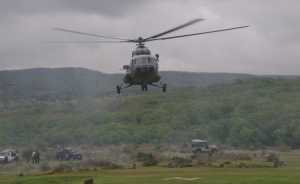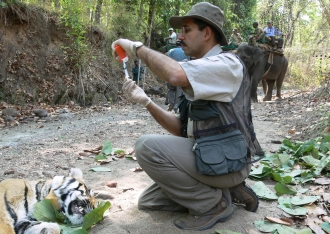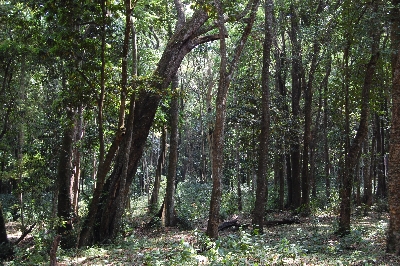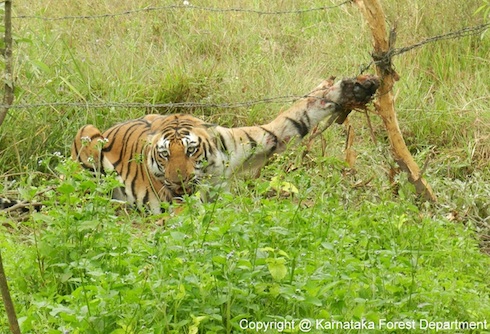Policing protected areas (PAs) means scanning through every centimetre of wildlife habitat: checking every tree, shrub, branch, leaf and twig for rope snares and preventing smuggling of all kinds of forest produce: be they timber, animals or products. Policing implies patrols to scan through every centimetre of soil to check for foot traps, and to peer through every water body, rock, crevice and cliff to protect the roaming wildlife 24X7X365.
One is proper surveillance network has to be established; secondly people residing in the core and periphery must cooperate with field staff, collection of evidence is tedious because material decomposes after a while, scattered evidence might not be easy to connect to poaching case in question says P S Somashekar, the field director of the Sariska Tiger reserve.
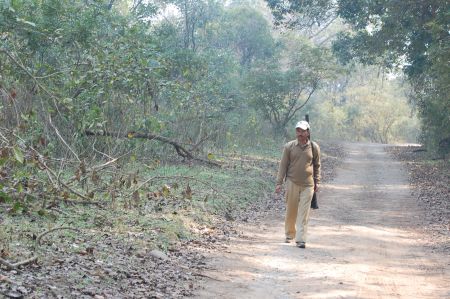
A forest guard embarks on his lonely forest patrol braving wind and wildlife without gadgets to protect him in Corbett Tiger Reserve. In case of any untoward incident he must walk up to the nearest guard station called Nakas and Chowkies and transmit the news to the HQs and then wait for additional forces to arrive. Forest guards are in charge of protecting the ecological integrity and should be treated on par with defense personnel, says Dandeli Tiger Reserve DCF Manoj Kumar. Pic: Malini Shankar.
Protection of forest wealth calls for effective roster systems of patrol duty, accountable staff, state of the art equipment, latest communication facilities, intelligence gathering, and rewarding informers, providing incentives to committed personnel, foolproof investigations, effective enforcement and prosecution, and sealing borders to prevent smuggling of wildlife derivatives.
The reality: poor working conditions, low budgets
Indias forest staff operate in appalling working conditions: Guards use open toed footwear, they lack simple facilities like torch jeep, wireless sets or gun. When they are posted in anti poaching camps in the desolate interiors of the forests, they lack both sanitation and protection against elements and wildlife. Forest guards often get their salary in arrears, and they live far away from their families. Forest officers rue that there is no foolproof system in place.
There is atleast a 50 per cent vacancy; trained personnel need to be recruited in all the PAs in the country. Those in service are aged, lacking motivation. Each guard gets Rs. 350 per month (apart from salary) as project allowance in Tiger Reserves, not in other PAs; commuting from their dwelling quarters to remote stations in the tiger reserves is onerous. Maintaining their families in two areas is virtually impossible says Manoj Kumar the Deputy Conservator of Forests at the Dandeli Anshi Tiger Reserve.
Chand served the sentence in the Ajmer jail till his 1st February 2008. He is serving term in another case in Jaipur Jail presently.

•
Taking stock of Sariska
•
Tribals, forest interdependence, and integra
Perceptively, the forest department has employed locals for foot patrol and offers them food rations, nutrition supplements, livelihood options in return for their vigilance inside the Protected Area. In a footnote to the tragedy in Sariska, Corbett has proven that policing can be effective if there is will and direction in the management says Bhartari, now deputy director in the Uttaranchal Tourism department.
In reserves where protection comprising foot patrols, permanent anti poaching camps at strategic locations alongwith mobile patrols are active 24X7X365, poaching activities can be controlled, agrees Praveen Bharghav of the Wildlife First. It is not only realistic but essential to employ local people with jungle skills in wildlife protection work The prevailing recruitment rules of the forest department emphasize scholastic learning over jungle craft and local origin, which does not facilitate hiring them except as temporary labourers. This is unfortunate and needs to change says Ullas Karanth, wildlife biologist of the Wildlife Conservation Society.
That the tiger is at the head of biodiversity is quantified by the documented crimes against wild boars, peacocks, hyenas, Sambhars, crocodiles, jungle cats, palm civets, mongoose, panthers, hares and jackals, in more than 75 wildlife crime cases booked in Sariska alone between 2002 and 2005. Bio piracy of insects, butterflies and leeches by well equipped and well informed foreign researchers is going on unchecked; legally - customs officials cannot check outbound goods, - thus, bio piracy is not even discovered much less prosecuted in India. Policing is even more challenging when it comes to protection of the minute faunal spectrum under the tigers stride.
Bemoaning the inefficacy of policing, a senior forest official in Rajasthan, speaking on condition of anonymity, attributes a series of errors causing the inevitable Sariska fiasco. During the peak of the poaching in Sariska in summer and monsoon months of 2004 the entire staff went on French leave; the system collapsed not top down but from bottom up. We need to address the problems of the staff: inadequate compensation and training, low motivation, and infrastructure.
There is also the original human-tiger conflict issue that impacts the value of policing. (See other articles in this series). On the 1st of September 2008, villagers of Chaan village on the periphery of the Ranthambore Tiger Reserve poisoned the carcass of the cow killed by a tigress; the tigress died. What kind of policing can possibly prevent anthropogenic conflict? Wherever half eaten carcasses of livestock because of carnivore depredation are reported, such carcasses should be incinerated in the presence of a gazetted officer to eliminate the possibility of poisoning for revenge killing by local people according to the Guidelines for preparation of Tiger Conservation Plan.
It is only by sterilising Protected Areas inviolate can we protect the wildlife. I fully agree that people are alienated but the problems of the periphery villagers have to be addressed says the senior forest officer.
Prosecuting poachers
The Wildlife Protection Society of India (WPSI) says it is aware of 10 tiger cases in which the accused were convicted.
One of the prominent and recent convictions is that of Sansar Chand. Chand is the most notorious wildlife trader in India having to his dubious distinction more than 45 cases filed by the forest and police departments in many states in India. He came out of prison in May 2004 by submitting fake medical certificates, and it is widely believed that he hired villagers in and around Sariska to vengefully kill all the 22 tigers in the monsoon months of that year.
Sansar Chand was convicted for 5 years and a fine of Rs. 60,000 was levied by additional chief judicial magistrate (Railways) Ajmer. Chand served the sentence in the Ajmer jail till his 1st February 2008. He is serving term in another case in Jaipur Jail presently.
Sharing the political will that helped successful prosecution of Chand, the then Superintendent of Police of the Government Railway Police in Ajmer Rajasthan, Hemant Priyadarshi who is presently DIG CBI, in Bhopal, says once involvement of Sansar Chand in this case became known, we put this case on highest priority, collected previous criminal record against Sansar Chand, and opposed any move for anticipatory bail right upto the Supreme Court. Priyadarshis team went the extra mile to collect chain of evidence to prove to the court the import of the arrest of Chand.
Other recent wildlife conviction cases, according to the WPSI, are as follows:
-
October 2008: 20 persons were convicted to 3 years RI and Rs 10,000 fine in connection with lions poaching in Gir National Park on March and April 2007.
October 2008: 1 person convicted to 3 years imprisonment, 2nd person to 1 and a half month and third person to two and a half months imprisonment for electrocuting lions in Gir.
September 2008: 1 Czech national sentenced to 3 years imprisonment in connection with butterfly smuggling in the Singalila National Park in Darjeeling.
July 2008: 1 person was convicted to 3 years RI and Rs 10,000 fine in Haridwar in connection with leopard bone smuggling.
Foolproof policing means administrative cohesion, transparent jurisprudence, effective prosecution, a sound land use policy, pooling intelligence, effective customs controls, inviolate protected areas, and a responsible civil society that rejects wildlife derivatives. Necessary infrastructure include state of the art equipment, all-terrain jeeps and boats, helicopter gunships, legal immunity for dutiful personnel, adequate fuel supply, wireless sets and satellite phones, binoculars, intelligence network, training, forensic skills, accountability, liaison with Interpol and scientific monitoring of data.
Lastly, media scrutiny of effective enforcement and successful prosecution serves the purpose of deterrence. All of these can be telling only if enforcement and prosecution serve as the deterrent it is meant to be. Media scrutiny is critically significant. Only a democratic ethos affords this kind of an elaborate institutional support, even as it, ironically, also offers rights to people charged with wildlife crime.




